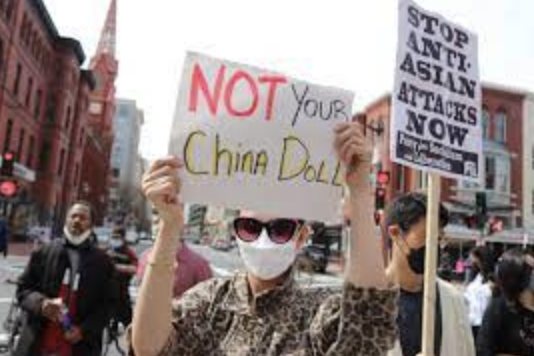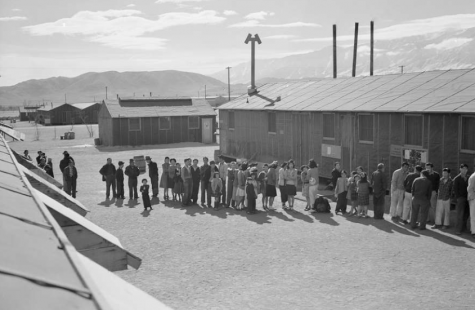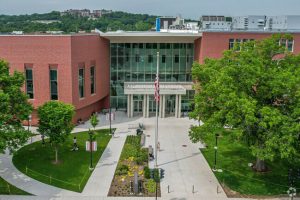Ottoson Students Discuss the Past, Present, and Future of Asian-American Identity

June 3, 2021
*Disclaimer* This article’s purpose is not to discredit the struggles that other minority groups have faced over the centuries. Asian-Americans didn’t have to face slavery, they came to America of their own will, and that has made a very large difference in the way history has played out. However, the Asian community has stayed mostly silent over the years, and their struggles have been unseen and unspoken of. This is an effort to bring awareness to some of these unsaid struggles.
America has a long history of scapegoating Asian-Americans and violating their rights, although many people don’t know the extent of the discrimination they have faced. After this tumultuous year with the COVID-19 pandemic and the rise in hate crimes against Asian-American people, the Asian-American community has come out to protest the centuries of marginalization this group has faced. This Asian-American and Pacific Islander (AAPI) month, Ottoson students spoke out with opinions on how we can help to integrate more Asian-American perspectives in school.
People of Asian descent have been coming to America for close to 175 years. Despite this, Asian-Americans are made to feel like foreigners in their own country. In 1790, the Nationality Act, which was passed by Congress and signed by George Washington, made it impossible for any person who was not white, free, and property-owning to become a naturalized citizen in the United States. Those from western Europe were granted access to citizenship, while those of different backgrounds were often not. This act significantly affected Asian-Americans who had hopes of finding a better life in America, and at the time were immigrating to the United States in large numbers. It paved the way for anti-Asian hate to become normalized. This act began a centuries-long journey for Asian-Americans to find their footing in this country. Restrictions on people of color’s eligibility to become naturalized were not lifted until 1952.
Many Asian people were first drawn to America because of the Gold Rush. However, when droves of Asian men left their families to find new opportunities, most of the immigrants were given dangerous, low-paying jobs without benefits. Unsatisfied with their work, they found a more stable job: building railroads. Asian-Americans were some of the biggest contributors to the building of the transcontinental railroad, and it is well documented. While they were working, they were also paid significantly less than white people for the same job, Gordon Chang told History magazine. Upon completion of the railroad, the photo that was taken of the laborers did not include Asian-Americans, and many historians cite anti-Asian prejudice as the reason for this exclusion.
Legal rights for Asian-Americans have also been abridged over the years. In 1854, a Chinese man witnessed a murder and testified in court against a white man. The California Supreme Court ruled that because Asian-Americans and all people of color were “a race of people whom nature has marked as inferior, and who are incapable of progress or intellectual development beyond a certain point,” they were unable to give trustworthy witness accounts. Furthermore, the case stated that in all future cases, “Chinese and all other people not white, are included in the prohibition from being witnesses against Whites,” asserted the California Supreme Court. This decision was not undone until 1882, when another murder took place. An Asian-American man, Yee Shun, allegedly murdered another Chinese-American. The owner of a laundromat was allowed to testify, along with two other Chinese immigrants. This set the precedent to allow all Asian-American people to testify in court, but this monumental case is often forgotten.
As time went on, animosity between Chinese-Americans and white people grew. Those of European descent were concerned that Chinese immigrants were taking their jobs away, which spurred what is now known as the Chinese Exclusion Act of 1882. This act, signed by Chester A. Arthur, the 21st U.S. President, meant that no Chinese immigrant could be naturalized as a citizen for the following ten years. This was implied in the Naturalization Act of 1790, but after the passing of the Chinese Exclusion Act, it became the first law regarding immigration that was strongly enforced and aimed at a specific country’s emigrants. Additionally, by singling out those of Chinese descent, hate for this community increased, making them a target of political cartoons and hate speech all over America. During these years, there were many acts of violence against Chinese-American people, including massacres in efforts to intimidate these communities and drive them out of the US. One such example was the Rock Springs Massacre, which occurred in 1885 in Wyoming. White workers in the mines resented the Chinese-Americans, and there was a fight in the mines one day. Most Chinese-Americans were still in Chinatown, due to a Chinese holiday. Between 100 and 150 white mine workers, angered by the fight, brought their weapons and gunned down 28 people and burned down 79 homes. The injured were not well-documented. The survivors boarded a train which they thought would take them to San Francisco, where it was supposedly safer. The train instead circled back around, and the Chinese immigrants were forced to return to work at the mines.
In 1892, when the jurisdiction of the Chinese Exclusion Act concluded, the Geary Act renewed the Exclusion Act for an additional ten years. Again, the act was extended in 1904, in the Extension of the Chinese Exclusion Act, which received much pushback from Asian-American communities in the form of boycotts. Because Chinese-Americans were unable to become citizens under the Chinese Exclusion Act, their right to vote was not granted until 1943, over 60 years later. The act that granted them their voting rights was known as the Magnuson Act, and effectively allowed for Chinese-Americans to become citizens and vote. However, this act is often seen as little more than a political statement to the Japanese in World War 2 (WWII). When the Magnuson Act was passed, the US State Department issued a statement as a pushback against the Japanese, explaining “The repeal of the Magnuson Act was a decision almost wholly grounded in the exigencies of World War II, as Japanese propaganda made repeated reference to Chinese exclusion from the United States in order to weaken the ties between the United States and its ally, the [People’s] Republic of China.” Even after the Magnuson Act, there was a maximum number of Chinese immigrants that could enter the United States every year. This number was only 105.
During WWII, America was on the side of the Allies, along with countries like Britain and the Soviet Union. On the opposing side, there were the Axis powers, countries such as Germany, Italy, and Japan. In 1941, Frankin D Roosevelt said that any potential threats or spies would be detained in internment camps. Although there were certainly many people from Germany and Italy taken into these camps, there were many more Japanese Americans, a great number of which had been living in America for generations. Notwithstanding that the Executive Order never explicitly stated that those of Japanese descent were to be targeted, it was clearly the intention. Gerald R. Ford, 38th President of the United States, when terminating Executive Order 9066 stated that the order was “…enforced by the criminal penalties of a statute enacted March 21, 1942, resulting in the uprooting of loyal Americans. Over one hundred thousand persons of Japanese ancestry were removed from their homes, detained in special camps, and eventually relocated.” Additionally, Henry L. Stimson, at the time the Secretary of War in America, was of the belief that those of Italian lineage were “potentially less dangerous, as a whole, than those of other alien nationalities.” He asked that the government “not disturb, for the time being at least, Italian aliens and persons of Italian lineage,” with the exception of those who were proven to be dangerous or a threat to America. The difference of most consequence between the internment of the Germans and Italians, and the Japanese, is that the Japanese were treated as if their whole country and their heritage was a danger while the German and Italian people had their own individual identities as their cases were studied on a person-to-person basis. Instead of looking at each case independently, instead of following the American ideal that all are innocent until proven guilty, the Japanese Americans living here were assumed to be guilty because of their appearances.

In more recent years, during the Korean and Vietnam Wars, Asian-Americans faced prejudice because white Americans with family members fighting in the war viewed them as the enemy. Many blamed Korean and Vietnamese people for the deaths of their family in combat.
In the late 1960s, the term “model minority” was coined by assimilationists in counter-protest to the Civil Rights movement. Assimilationists are those who think that minorities should only be accepted if they are similar to themselves, often believing themselves to be “not racist.” In reality, the belief that a group of people should only be accepted if they are similar to the majority is a racist belief because of the lack of acceptance for people the way they are. The idea of the model minority was that if Japanese people went through internment camps and still did well in life after the fact, then there was no reason why Black people, following slavery, and Latinx people, could not also. The term “model minority” is hurtful to all minority groups. Asian-Americans to this day still live under the unfair expectations society puts upon them; the expectation of the 4.0 GPA and the instrument-playing-rule-follower personality. The idea that Asian-Americans are the “model minority” is not completely a myth, however, it was never completely true. To this day, the model minority idea is used to justify hatred towards Black and Latinx demographics, as well as attribute academic excellence from Asian people to their race. People these days still insist upon this idea that Asian-Americans should be the example to other minorities. That is not to say that this assumption has not also propelled Asian-Americans to raise their social standings. Asian-Americans have the highest median income, even surpassing median white incomes, because of the high cost of immigration, academic focus, and limited numbers of data points. Asian-Americans make up only 6% of the American population, and within that 6%, many are wealthy and have higher education levels. It is also important to acknowledge, however, that Asian-Americans have the largest pay gap within their demographic, with many very successful individuals on one end of the spectrum, and many struggling immigrants on the other. A case in point; Burmese Americans, on average, have one of the lowest median incomes in America and the lowest within the Asian-American demographic, according to Pew Research. They are also one of the most recent Asian groups to immigrate to America and one of the least likely Asian-American groups to speak proficient English.
Asian-Americans are still facing prejudice. With the COVID-19 virus originating out of Wuhan, China, Asian-Americans have been scapegoated as the reason for the national hardship caused by the pandemic. This year, prejudice against Asian-American people has come to light in the form of hate crimes and documented harassment. Although there has been significant progress in combating anti-Asian racism both socially and within government, there are still struggles in the modern day. There has been desensitization to microaggressions Asian-Americans experience, such as the use of slurs against Asian people specifically, or the pulling of eyelids to “mimic” the eyes of those with East Asian heritage. There has been a cherry-picking of Asian culture, as non-Asian Americans will gladly take Manga, calligraphy, and Americanized Chinese food, but still hold prejudice against the people who introduced these things to Western culture. There is a lack of Asian-American representation in film, politics, popular music, and sports. Today, in the midst of a pandemic that has claimed the lives of so many, hatred towards Asian-Americans has caused unnecessary additional deaths all over the world.
Asahi A., a Japanese emigrant and Ottoson student was upset by some of the racism she’s seen and experienced in America. She told a story about how her family was treated differently because of their appearance in a restaurant. A waiter was not kind and cordial to her family when they had just seen the waiter’s personable treatment towards a white family. Asahi explained that she believed that this interaction was related to race. “That’s what I assumed,” she said. Although Asahi has had some negative experiences due to her race, she expressed that she didn’t feel ashamed of her background or of being Asian. “There are times, obviously, where I’m treated unjustly, sure. [However, by] being who I am […] you get to be proud of who you are and where you come from. At least where I [live (Arlington)], people respect that.”
Ruhaan S., an American-born son of Indian immigrants, explained how his Indian heritage has shaped him. He explained that he often visits India, has participated in an Association for India’s Development (AID) conference and has gone to festivals celebrating his Asian heritage. He did think, however, that Indian Americans have not always been recognized as Asian-Americans. “I think when people think of Asians, they think of […] people from East Asia, while in reality, Asia is massive, and goes from the Sinai Peninsula of Egypt to far east Siberia to Indonesia,” he explained in a recent interview. He then asserted that people of East Asian descent have a “bigger presence” in the western world, and that contributes to the lack of awareness of Indian-American people’s identity as Asian-American. He told his personal experience of having people express surprise at hearing that he identifies as Asian-American and curiosity about what people on the receiving ends of surveys that ask for a participant’s race assume about his identity.
Amethyst S., an Ottoson student with Chinese, Vietnamese, and Polish backgrounds, felt that Ottoson could do more to help students of non-European backgrounds. “My sister’s fifth-grade class is having deeper discussions about race than we are in middle school,” she explained in a recent interview. She continued to elaborate, stating that she thinks the school has worked hard to make a more diverse set of voices heard, and that they are “doing a good job starting.” However, she was of the opinion that there hasn’t been enough depth in these efforts, especially for Asian-American students, asking for “more open discussions” and additional work to help students “feel that they are safe and welcomed in our school environment.” She recommended the integration of books by a wider variety of authors and for more time in classes to have open conversations regarding recent racial events.
The history of racism towards any minority group is disheartening and grim. However, the future can benefit from education in empathy, more understanding of a diverse array of cultures, and a critical eye to others’ and your own biases.
For more resources on the history of Asian-American Hate visit:
https://immigrationhistory.org/timeline/
https://www.history.com/topics/immigration/asian-american-timeline
For more on how to support the Asian-American community:
https://smithsonianapa.org/learn/
https://www.learningforjustice.org/the-moment/march-15-2021-addressing-antiasian-bias








Manisha Sharma • Jun 4, 2021 at 9:54 pm
Thank you for sharing this historical perspective of racism towards Asian Americans in the United States. Many racist attitudes unfortunately persists even to this day. I thought that this article was composed very well and presented the history concisely and clearly. It has helped me learn so much. Well done!